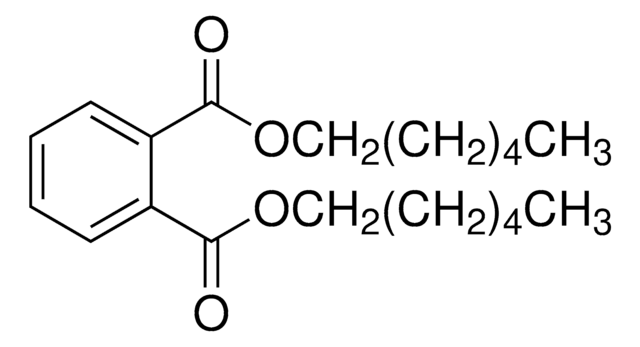80153
Di-n-octyl phthalate
≥98.0% (GC)
Synonym(s):
DNOP, Phthalic acid di-n-octyl ester
About This Item
Recommended Products
Quality Level
Assay
≥98.0% (GC)
form
liquid
refractive index
n20/D 1.485
acid value
≤3
density
0.980 g/mL at 20 °C (lit.)
functional group
ester
SMILES string
CCCCCCCCOC(=O)c1ccccc1C(=O)OCCCCCCCC
InChI
1S/C24H38O4/c1-3-5-7-9-11-15-19-27-23(25)21-17-13-14-18-22(21)24(26)28-20-16-12-10-8-6-4-2/h13-14,17-18H,3-12,15-16,19-20H2,1-2H3
InChI key
MQIUGAXCHLFZKX-UHFFFAOYSA-N
Looking for similar products? Visit Product Comparison Guide
General description
Application
- Unified BARGE Method for Phthalate Migration: A simplified unified BARGE method has been proposed to assess the migration of phthalate esters from ingested PVC consumer products. This study focuses on the migration behaviors of phthalates like Di-n-octyl phthalate, aiding in regulatory assessments and consumer safety evaluations (Mohamed et al., 2023).
- ECTFE Porous Membrane for Dehumidification: The development of an ECTFE porous membrane for dehumidification of gaseous streams through a membrane condenser introduces a novel application of membrane technology, potentially incorporating Di-n-octyl phthalate as a process agent, enhancing industrial gas separation and purification processes (Pan et al., 2022).
Hazard Statements
Precautionary Statements
Hazard Classifications
Aquatic Chronic 4
Storage Class Code
10 - Combustible liquids
WGK
WGK 1
Flash Point(F)
228.2 °F - closed cup
Flash Point(C)
109.0 °C - closed cup
Personal Protective Equipment
Choose from one of the most recent versions:
Already Own This Product?
Find documentation for the products that you have recently purchased in the Document Library.
Customers Also Viewed
Our team of scientists has experience in all areas of research including Life Science, Material Science, Chemical Synthesis, Chromatography, Analytical and many others.
Contact Technical Service









